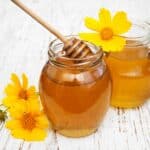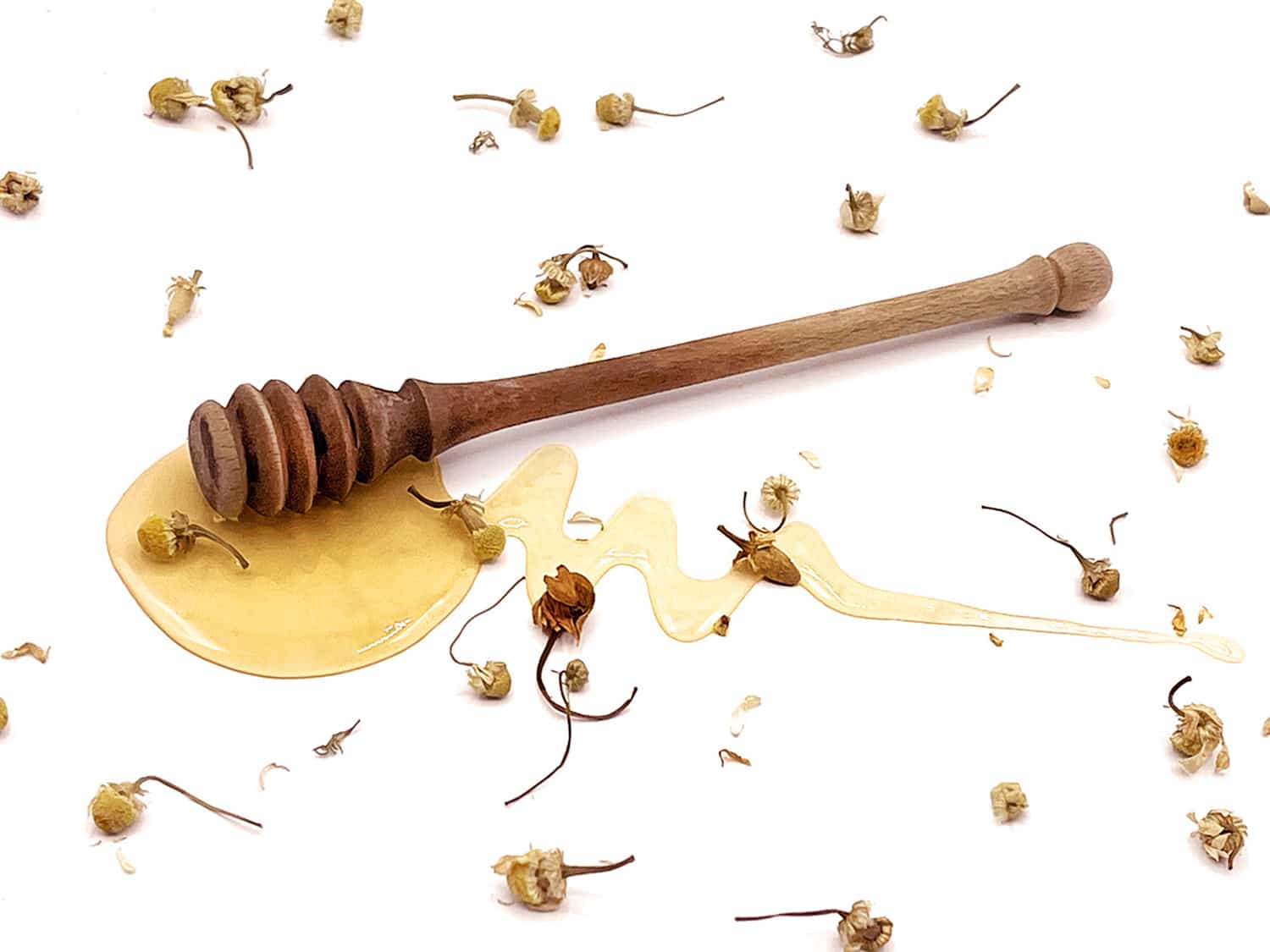

Seriously, who doesn’t love honey?
Not only is it delicious, it also possesses remarkable medicinal properties. Healers and herbalists across cultures and continents have recognized honey’s remarkable healing potential!
The use of honey for medicinal purposes is ancient and almost certainly predates written records. Ceramic jars containing honey residue were found in the ancient settlement of Aradetis Orgora in the country of Georgia, which dates back approximately 5,500 years.
The earliest record of honey used medicinally is found in the Ebers Papyrus, one of the oldest and most significant ancient Egyptian medical texts, dating back to ~1550 BCE. It contains more than 800 individual prescriptions, including many remedies involving honey for everything from digestive disorders to coughs and sore throats. The text also recognizes honey’s antimicrobial properties and its ability to help in the healing of wounds and topical skin conditions.
The ancient Greeks, including renowned physicians Hippocrates and Dioscorides, valued honey for its healing properties and documented its use in treating various ailments. Traditional systems of medicine such as Ayurveda, Traditional Chinese Medicine (TCM) and traditional European herbal medicine all incorporate honey as a carrier (menstruum) for herbal remedies, recognizing its ability to enhance the efficacy and palatability of medicinal preparations.
An interesting menstruum
When it comes to crafting herbal preparations, the choice of a suitable menstruum — aka a solvent used to extract the therapeutic properties of herbs — is of utmost importance. Honey acts as a moderate-to-strong menstruum, unique in its ability to extract water-soluble constituents as well as small amounts of oil-soluble compounds.
At the heart of honey’s solvent capabilities lies its hygroscopic nature — that is, its ability to absorb moisture from its surroundings. In humid environments, honey can absorb water vapor and maintain a lower water content than its surroundings. In dry environments, honey releases moisture into the air, acting as a natural humidifier. This property makes honey an effective menstruum for extracting water-soluble compounds like antioxidants, tannins, enzymes, vitamins, minerals and other phytochemicals.
In addition to its water-extraction capabilities, raw honey can also draw out small amounts of oil-soluble compounds, thanks to the presence of trace amounts of beeswax and pollen lipids. While the concentration of these oil-soluble compounds is relatively low, they contribute to the overall potency of herbal honey.
Some studies suggest that honey may be capable of enhancing the bioavailability of certain plant compounds, optimizing the therapeutic benefits of herbal remedies. How cool is that? When used as a menstruum alongside therapeutic herbs, honey can enhance the overall efficacy of the remedy while adding its own nutritional profile and beneficial properties to the mix! ♥

A time-tested preservative
As mentioned previously, honey is famous for being one of the oldest known preserved foods. Archaeological excavations have uncovered containers of unspoiled honey dating back thousands of years! This remarkable longevity has contributed to honey’s reputation as an almost supernatural food preservation substance.
Honey’s natural preservative qualities can be attributed to its low water content, acidic pH and enzymatic activity. These factors work together to inhibit the growth of microorganisms, making honey an effective tool for preserving the active constituents of herbs and extending their shelf life.
One of the key contributors to honey’s preservation power is its osmotic effect. The high sugar concentration in honey creates a hypertonic environment, which just means there is a higher concentration of solutes (sugars in this case) compared to the surrounding environment. This osmotic effect draws water out of any microorganisms present, dehydrating them and making it challenging for bacteria, fungi and other pathogens to take hold.
Honey’s naturally low pH further adds to its antimicrobial properties, creating an inhospitable environment for many microorganisms. Certain enzymes present in honey also produce hydrogen peroxide, which is an antimicrobial.

Synergistic effects
As you can see, honey is no ordinary menstruum! In addition to acting as both a carrier and enhancer of herbs, raw, unfiltered honey* is a treasure trove of bioactive compounds, all of which contribute to its nutritional and therapeutic properties.
Honey is primarily composed of glucose and fructose with varying amounts of water and enzymes. Organic acids like gluconic acid contribute to its acidic pH, which typically ranges from 3 to about 4.5. Honey also contains phenolic compounds, amino acids, minerals, trace elements and small amounts of vitamins. Other components may include pollen grains, propolis, wax particles and volatile organic compounds. The specific makeup of honey will vary based on factors such as floral source and processing methods.
Plain, raw, unfiltered honey possesses a number of therapeutic properties in its own right — including antimicrobial, anti-inflammatory and wound-healing actions. For example, honey can have a moisturizing and soothing effect on the throat, helping alleviate sore throats and dry coughs. Its natural thickness and stickiness create a coating effect, providing a soothing protective layer to irritated tissues.
Eating raw, local-to-you honey can also be beneficial to those with seasonal allergies. Local honey contains trace amounts of pollen from a wide array of local plants. By consuming it, you expose your body to small doses of the same allergens that trigger your seasonal allergies. The idea is that this gradual exposure can desensitize the body and, over time, help your immune system become less sensitive to the allergens.
* Note that “raw honey” refers to honey that has not been heated, pasteurized or processed in any way that would alter its natural composition or destroy its enzymes.

Just a spoonful of sugar…
Mary Poppins knew what she was talking about! ♫
Many herbal remedies have bitter or strong flavors that can be challenging to consume. Honey’s sweet taste can help mask bitterness or unpleasant flavors of certain herbs, making herbal preparations more palatable and enjoyable to consume — particularly for children or anyone with sensitive taste buds.
Herbal medicine is of no use if you can’t get people to take it! As herbalist Suzanne Tabert is fond of reminding us, honey is one way to help you “get the medicine to the people in a way they’ll love to take!” ♥
One exception to this rule is with bitter herbs. Bitters must taste bitter in order to work as a bitter.
Got that? 😉
Bitters work by stimulating the bitter taste receptors on the tongue, which in turn triggers a cascade of physiological responses, including the secretion of saliva, bile and gastric acids, which aid in breaking down food, enhancing nutrient absorption, promoting peristalsis and supporting overall digestion. But without the bitter flavor to interact with our taste receptors, bitters do those things.
So in this case, it’s probably a good idea to save the honey for other applications…

Other herbal preparations using honey
Speaking of other applications, honey is a versatile medium for creating all sorts of herbal preparations. In its simplest form, it can be added (either plain or infused) to herbal infusions or herbal teas (tisanes), creating a soothing and naturally sweetened beverage that also harnesses some of the health benefits of honey.
Similar to herbal honeys, electuaries are a type of herbal preparation in which powdered herbs are blended into a sweet, sticky base — usually honey — to create a paste that can be taken by the spoonful or spread onto other foods for a palatable and convenient form of herbal medicine.
Herbal syrups are popular for their therapeutic properties and pleasant taste. Herbs are typically simmered or infused in water, making a strong decoction, before straining and then combining with an equal amount of sweetener such as honey (plain or infused) to create a concentrated syrup.
Oxymels combine the goodness of vinegar with honey and herbs. Herbs are usually macerated in a 50-50 blend of raw, unpasteurized vinegar and honey to extract their constituents. Oxymels may be taken by the spoonful or added to beverages for a tart and sweet herbal remedy.
Herbal elixirs are prepared by macerating herbs in alcohol (traditionally brandy) and then blending the strained liquid with a sweetener such as honey.
Honey can act as a binding agent for herbal powders or extracts, allowing the formation of herbal pills or pastilles. These convenient and portable forms of herbal medicine provide a discreet way to consume herbs and support specific health goals.
Honey can also be incorporated into herbal salves for topical application. These preparations combine herbs with carrier oils, beeswax (or cera bellina) and honey, resulting in soothing and nourishing products for the skin.
Compresses involve applying a cloth soaked in a liquid to a specific area of the body for therapeutic effect. Honey can be mixed with herbal infusions, decoctions, juices (succus) or other herbal liquids to create a honey-based compress. Compresses are often used for localized pain relief, inflammation or wound healing.
Honey can also be combined with powdered or mashed herbs to create a honey-based poultice. The honey helps bind the herbal material together and provides its own beneficial properties. Poultices involve applying a moist mass of herbs directly to the skin and are commonly used for skin irritations, minor wounds and inflammation.

Basic Herb-Infused Honey
5 Stars 4 Stars 3 Stars 2 Stars 1 Star
No reviews
Ingredients
fresh herbs to loosely fill a pint sized mason jar or, if using dried herbs, to about the halfway point
raw, unfiltered honey (preferably local)
Instructions
- Wash your fresh herbs and spread them out on paper towels or a wire cooling rack. Allow to dry and wilt overnight to eliminate excess moisture that can lead to mold growth.
- Add herbs to a clean mason jar and cover with honey until jar is full and the leaves are fully submerged. If honey is too solid to pour, gently heat it by placing it in a warm water bath. Take care not to heat the honey beyond about 110F, or you risk destroying its beneficial enzymes.
- Secure the jar’s lid, and place in a sunny windowsill.
- Flip the jar onto its lid once a day or so. This ensures that the mint is staying submerged under the honey. You do not want the mint exposed to any oxygen or you risk contamination and bacteria growth.
- Infuse for 2-4 weeks, allowing plenty of time for the herb’s medicinal properties and flavor to extract into the honey.
- Strain out the herbs using a fine mesh strainer, making sure there is no remaining plant matter in your infusion. Gentle heat (again, keep it below 110F) will help thin the honey sufficiently to strain easily. ♥



